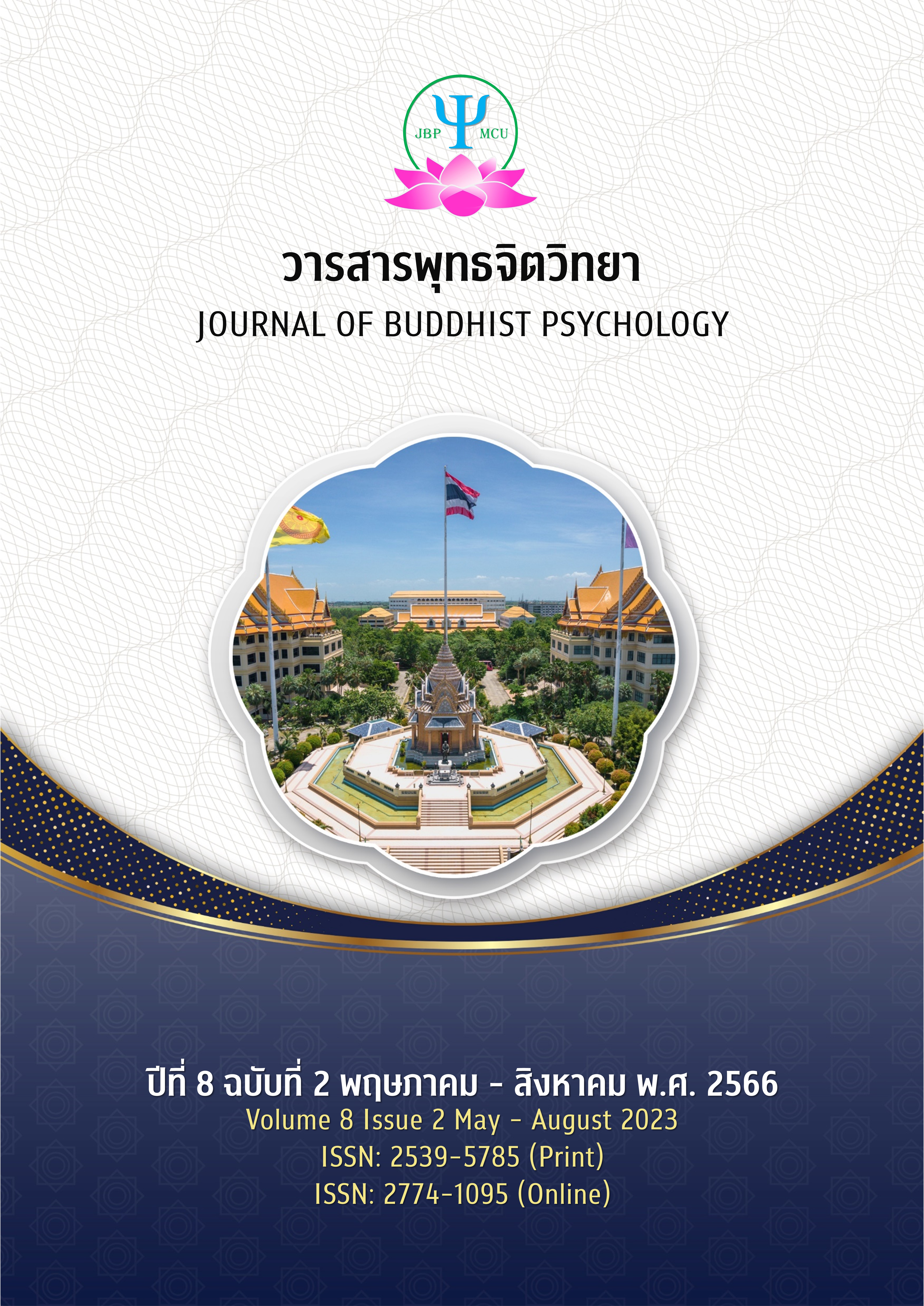บทบาทของพยาบาลในการส่งเสริมความสุขด้วยจิตวิทยาเชิงบวกในยุควิถีชีวิตถัดไป
Main Article Content
บทคัดย่อ
จากสถานการณ์การแพร่ระบาดของโรคโควิด-19 ทำให้รูปแบบการใช้ชีวิตของผู้คนทั่วโลกเปลี่ยนไป ทั้งด้านพฤติกรรมและทัศนคติในการดำรงชีวิต ส่งผลกระทบต่อความสุขซึ่งเป็นสิ่งที่มนุษย์ทุกคนต้องการและแสวงหา ถึงแม้ปัจจุบันต้องดำเนินชีวิตในรูปแบบปกติใหม่ (New Normal) และโรคโควิค-19 ก็ได้กลายมาเป็นโรคประจำถิ่น (Endemic) เปลี่ยนแปลงวิถีการดำเนินชีวิตจากแบบปกติใหม่ เป็นแบบวิถีชีวิตถัดไป (Next Normal) ซึ่งจิตวิทยาเชิงบวก (Positive psychology) เป็นแนวคิดที่ศึกษาถึงการเสริมสร้างอัจฉริยภาพของบุคคล ด้วยการยึดเอาจุดแข็งของบุคคลมาเป็นศูนย์กลางในการพัฒนา มีเป้าหมายเพื่อให้มนุษย์มีความสุขอย่างแท้จริง ซึ่งเป็นความสุขที่ยั่งยืน ดังนั้นพยาบาล ซึ่งมีบทบาทในการส่งเสริมสุขภาพแบบองค์รวม ได้แก่ ร่างกาย จิตใจ สังคม จิตวิญญาณ และจิตปัญญา จึงต้องมีความรู้และทักษะที่จะช่วยชี้แนะ สนับสนุน ให้คนสามารถพัฒนาความสุขที่แท้จริงของตนเอง เพื่อให้คนในสังคมข้ามผ่านความเปลี่ยนแปลงต่าง ๆ ได้อย่างมีความสุข
Article Details

อนุญาตภายใต้เงื่อนไข Creative Commons Attribution-NonCommercial-NoDerivatives 4.0 International License.
เอกสารอ้างอิง
กมลพร กัลป์ยาณมิตร. (2564). ทักษะจำเป็นแห่งอนาคต การทำงานยุคหลังโควิด-19. วารสาร มจร พุทธปัญญาปริทรรศน์, 6(3),163-176.
กรมควบคุมโรค. (2563). โรคติดเชื้อไวรัสโคโรนา 2019 (COVID-19). สืบค้นเมื่อ 2 พฤษภาคม 2566, จาก https://ddc.moph.go.th/viralpneumonia/index.php.
กฤตพล สุธีภัทรกุล. (2565). 20 มี.ค. "วันความสุขสากล" แล้ว "ความสุข" ของ "คนไทย" อยู่ตรงไหน?. สืบค้นเมื่อ 2 มีนาคม 2566, จาก https://www.bangkokbiznews.com/social/994508
เกสร มุ้ยจีน. (2559). การสร้างความสุขด้วยจิตวิทยาเชิงบวก. วารสารวิทยาศาสตร์และเทคโนโลยี, 24(4), 673-681.
จอมขวัญ เลื่องลือ. (2565). ประสิทธิผลของโปรแกรมจิตวิทยาเชิงบวกต่อความสอดคล้องกลมกลืนในชีวิต. วารสารจิตวิทยา, 20(2), 43-57.
ฉวีวรรณ สัตยธรรม, แผ จันทร์สุข และศุกร์ใจ เจริญสุข. (2557). การพยาบาลจิตเวชและสุขภาพจิต (ฉบับปรับปรุง) เล่มที่ 1. (พิมพ์ครั้งที่ 2). นนทบุรี: โครงการสวัสดิการวิชาการ สถาบันพระบรมราชชนก .
ชิโนรส ลี้สวัสดิ์. (2565). ความสุขคนไทยและรายงานความสุขโลก. สืบค้นเมื่อ 2 มีนาคม 2566, จาก http://www.dsdw2016.dsdw.go.th/doc_pr/ndc_2560-2561/PDF %8C.pdf
วิชัย เทียนถาวร. (2561). สุขภาพองค์รวม…แนวพุทธ. สืบค้นเมื่อ 20 พฤษภาคม 2566, จากhttps://www.matichon.co.th/columnists/news_907268
ญานิศา ดวงเดือน. (2563). พยาบาลกับการส่งเสริมการระลึกความหลังในผู้สูงอาย. วารสารพยาบาลทหารบก, 2(2),17-25.
ธนิสา ทวิชศรี, บุญธิดา เสงี่ยมเนตร. (2564). วิกฤตโควิด-19 กับปัญหาสุขภาพจิตในประเทศไทย. สืบค้นเมื่อ 20 พฤษภาคม 2566, จาก https://thaipublica.org/2021/06/pier-67/
นันท์ชัตสัณห์ สกุลพงศ์, ขวัญใจ ฤทธิ์คำรพม และไพลิน ลิ้มวัฒนชัย. (2562). ผลของกิจกรรมกลุ่มด้านจิตวิทยาเชิงบวกต่อความสุขและการปรับตัวทางสังคมของนักเรียนชั้นมัธยมศึกษาในโรงเรียนประจำ: การวิจัยแบบผสานวิธี. วารสารพฤติกรรมศาสตร์เพื่อการพัฒนา, 11(1),35-52.
บุษกร วัฒนบุตร. (2558). องค์กรแห่งความสุขและคุณภาพชีวิต. วารสาร มจร สังคมศาสตร์ปริทรรศน์, 4(1),65-77.
ปริญญาภรณ์ ธนะบุญปวง. (2565). การดูแลสุขภาวะและคุณภาพชีวิตผู้สูงอายุในยุคปกติถัดไป. วารสารวิจัยเพื่อการส่งเสริมสุขภาพและคุณภาพชีวิต, 2(1),86-96.
ภัทรพรรณ บุญยะปานะสาร, อังศินันท์ อินทรกำแหง, อัจศรา ประเสริฐสิน. (2563). ผลของโปรแกรมการให้คำปรึกษารายบุคคลเพื่อเสริมสร้างการมองโลกในแง่ดีที่มีต่อความสุขที่แท้จริงของผู้ดูแลผู้ป่วยโรคเรื้อรัง. วารสารการวัดผลการศึกษา, 37(101),18-32.
สุดารัตน์ ตันติวิวัทน์. (2560). จิตวิทยาเชิงบวก: แนวคิด การพัฒนา และความท้าทายในอนาคต. วารสารพฤติกรรมศาสตร์เพื่อการพัฒนา, 9(1),277-290.
สุพิชญา วงศ์วาสนา. (2564). ปัจจัยผลกระทบทางลบจาก COVID-19 ส่งผลต่อความสุขในการทำงานของพนักงานฝ่ายการโดยสาร กรณีศึกษา บริษัท บางกอกไฟลท์เซอร์วิสเซส จำกัด (BFS). วารสารรัชต์ภาคย์, 15(39),15-30.
อภินันท์ จันตะนี, ประพันธ์ แสงทองดี. (2565). วัฒนธรรมองค์กรในยุคดิจิทัล. วารสาร มจร ภาษาและวัฒนธรรม, 2(1),52-62.
ฮูดา แวหะยี. (2563). การรับรู้ความรุนแรงและพฤติกรรมการป้องกันโรคติดเชื้อไวรัสโคโรน่า 2019 (โควิด-19) ของวัยรุ่นในเขตตำบลสะเตงนอก อำเภอเมือง จังหวัดยะลา. วารสารวิชาการสาธารณสุขชุมชน, 6(4), 158-168.
Aknin L.B, Dunn E.W., Norton M.I. (2012). Happiness runs in a circular motion: evidence for a positive feedback loop between prosocial spending and happiness. Journal of Happiness Studies, 13(1), 347-355.
Argyle, M., & Martin, M. (1991). The psychological causes of happiness. International Series in Experimental Social Psychology, 21(1), 77–100.
Artsanthia, J., Pitplearn, N., & Prachyakoon, N. (2022). Direction of health care in pandemic of Corona Virus 2019 in new normal of community nurses. Journal of The Royal Thai Army Nurses, 23(1), 57-64.
Bolier L., Haverman M., Westerhof G. J., Riper H, Smit F, Bohlmeijer E. (2013). Positive psychology interventions: A meta-analysis of randomized controlled studies. BMC Public Health, 13(119).
Carr A, Cullen K, Keeney C, Canning C, Mooney O, Chinseallaigh E. (2020). Effectiveness of positive psychology interventions: a systematic review and meta-analysis. The Journal of Positive Psycholog, 16, 749-769.
Chérif, L, Wood V.M, Watier C. (2021). Testing the effectiveness of a strengths-based intervention targeting all 24 strengths: results from a randomized controlled trial. Psychological Reports, 124(3),1174–1183.
Duckworth, L.A., Steen, T.A., & Seligman, M. E. (2005). Positive psychology in clinical practice. Annual Review of Clinical Psychology, 1,629-651.
Howell, T, Pchelin P, Iyer R. (2012). The preference for experiences over possessions: Measurement and construct validation of the experiential buying tendency scale. Journal of Positive Psychology, 7(1),57-71.
Kurtz, J.L. (2012). Seeing through new eyes: An experimental investigation of the benefits of photography. Unpublished manuscript.
Layard, R. (2005). Happiness: Lessions from a new science, Couns. Psychot. Res, 6,302-303.
Louis, M. (2011). Strength interventions in higher education: Effects on implicit self-theory. Journal of Positive Psychology, 6(1),204-215.
Magyar-Moe, J.L., Owens, R.L., Conoley C.W. (2015). Positive psychological interventions in counseling: what every counseling psychologist should know. The Counseling Psychologist, 43(4),508–557.
Manion, J. (2003). Joy at work: Creating a positive workplace. Journal of Nursing Administration, 33,652-655.
Maslow, H. A. (1954). Motivation and Personality. New York: Harper & Row.
Panagiota ,T. & Jolanta, B. (2022). Positive psychology intervention (PPI) coaching: an experimental application of coaching to improve the effectiveness of a gratitude intervention, Coaching: An International Journal of Theory. Research and Practice, 15(1),131-142.
Reilly M, Trial J, Piver E, Schaff B. (2012). Using theatre to increase empathy training in medical students. Journal for Learning through the Arts, 8(1), 1-8.
Schueller, S.M. & Parks, A.C. (2014). The science of self-help: translating positive. psychology research into individual happiness. European Psychologist, 19(1),145-155.
Seligman, M. E. P. (1998). Learned optimism. New York: Pocket Books.
Seligman, M. E. P. (2000). Authentic happiness: using the new positive psychology to realize your potential for lasting fulfillment. New York: Free Press.
Seligman, M. E.P., & Csikszentmihalyi, M. (2000). Positive psychology. An introduction. The American Psychologist, 55(1),5–14.
Seligman M.E, Rashid T, Parks A.C. (2006). Positive psychotherapy. American Psychologist, 61(1),774-788.
True Digital Academy. (2021). Digital skills an important step into the future. Retrieved May 20, 2023, from https://www.truedigitalacademy.com/blog/ทักษะดิจิทัล-digital-skills-ก้าว
Veenhoven, R. (1996). Happy life-expec-tancy: A comprehensive measure of quality-of-life in nations. Social Indicators Research, 39,1-58.
Wong P. T. P. (2010). Meaning therapy: An integrative and positive existential psychotherapy. Journal of Contemporary Psychotherapy, 40,85-93.
Wong, P. T. P. (2017). Meaning-centered approach to research and therapy, second wave positive psychology, and the future of humanistic psychology. The Humanistic Psychologist, 45(3), 207–216.


